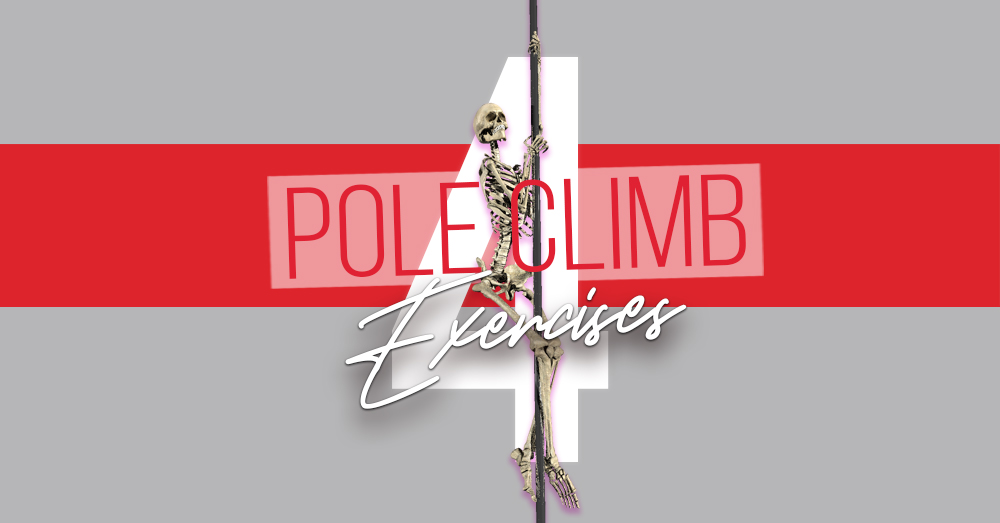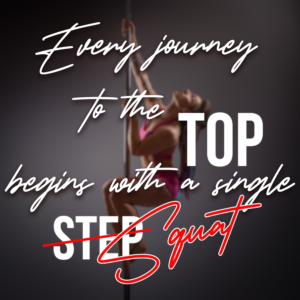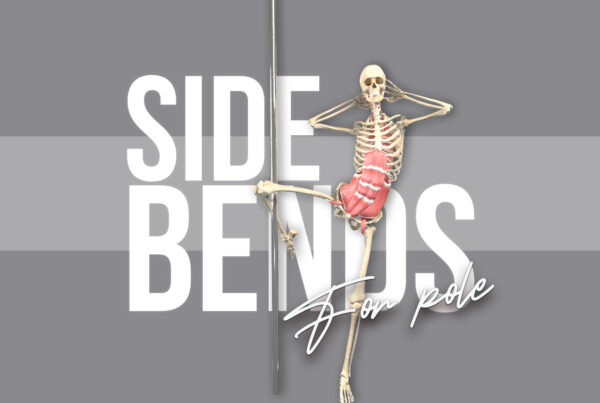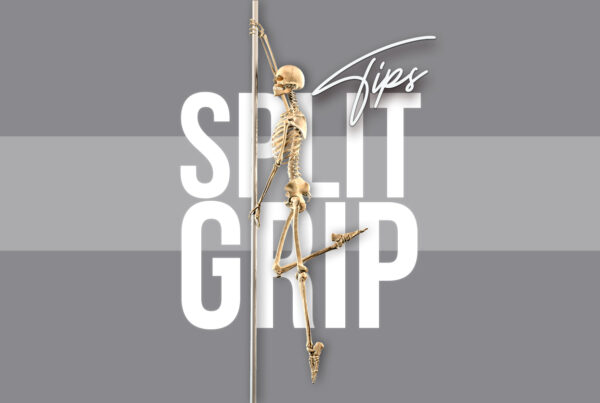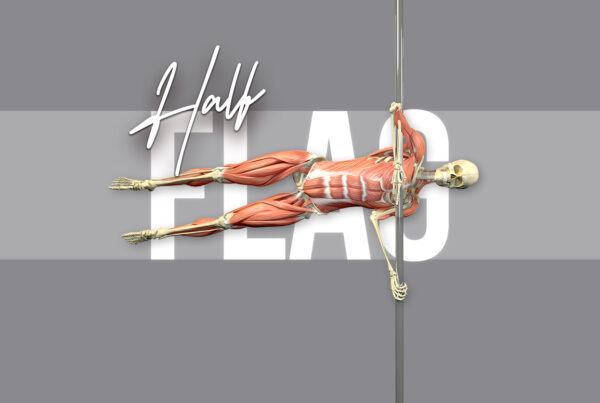My increasingly snug fitting t-shirt sleeves are testament to the fact that pole is, without doubt, a movement practice that relies heavily on upper-body strength.
But it’s not all about the gun show or lats like the wings of an albatross!
When we use our WHOLE body to support how we move up, down and around the pole, it helps us spread the load of our spins, climbs and inverts across multiple muscle groups and joints. Thus reducing the risk of overloading any one particular area AND making our movement patterns more efficient (in other words, easier!).
In short: our butt can reduce the demand we place on our shoulders when we pole.
Say whaaat?! Why, thanks magic peach! 🍑💪
If you’re doubting the importance of leg strength in pole and/or if you’re working on building strength for climbing, read on! In this post we’re about to:
- Take a closer look at the role our lower body plays in the pole climb movement.
- Check out 4 of my exercise selections for a climb-specific leg day!
Working on your pole climb strength? Maybe it’s time to give your lower body the love it needs to help you make it to the top!
Leg strength in the pole climb
Let me briefly start by saying this: there are many ways to climb a pole!
In this post, I’m talking about the variation of the forearm climb which I’m demo-ing in the video below – and, more specifically, how we can use the muscles of our legs to assist with this climb movement.
Rather watch than read? I got you! Check out the 90-second video version of this anatomy breakdown below:
Have you ever noticed how the main part of the pole climb movement is weirdly similar to a squat?
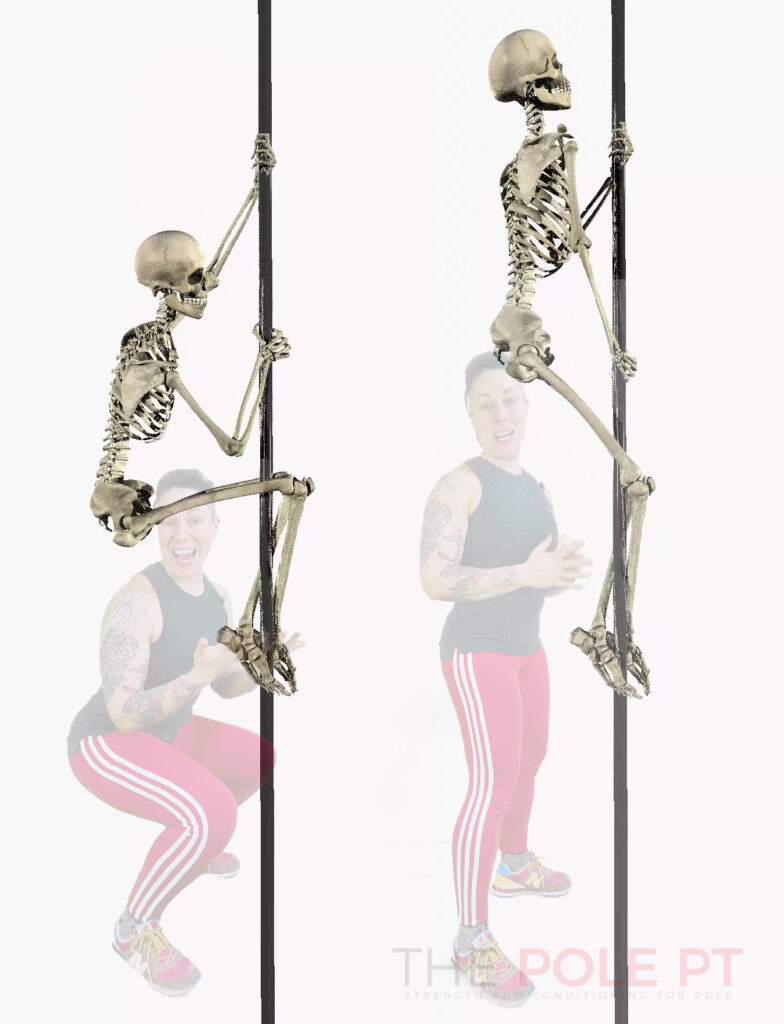
Interesting, huh?! There are some big differences, though…
When we climb, we don’t have the ground to push against. Instead, we’re using our adductors (our inner thigh muscles) to squeeze our knees together and grip the pole between our legs.
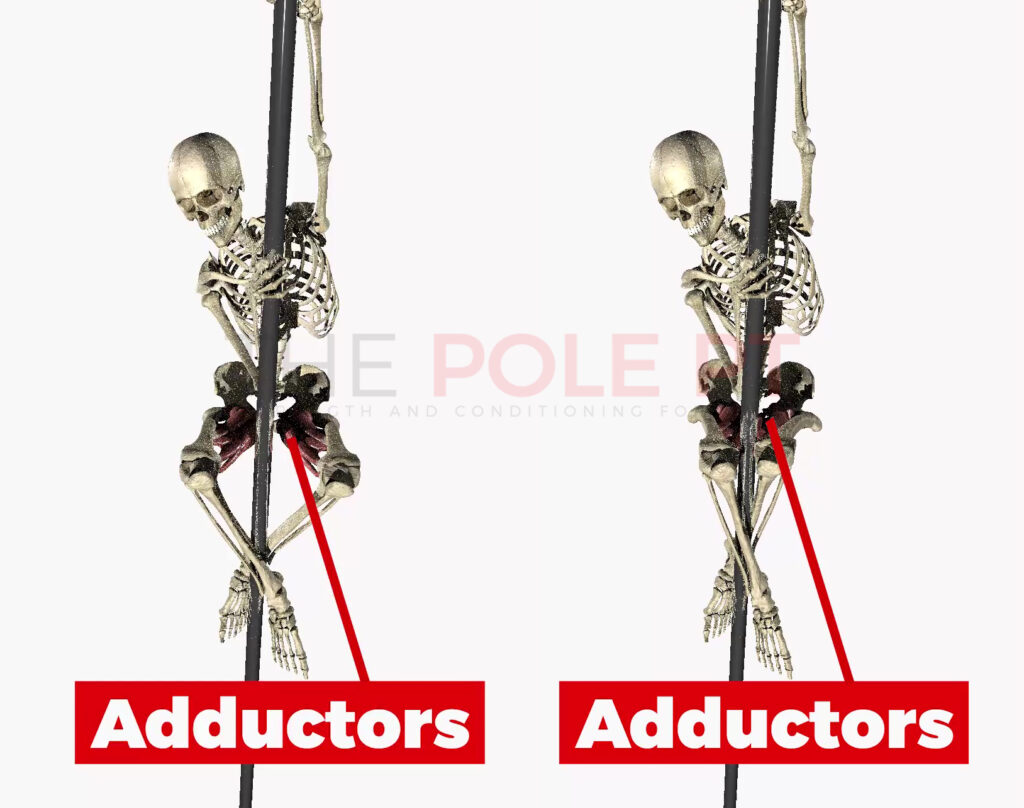
The quads (quadriceps) on our back leg are working to actively press the lower leg into the pole, while the hamstrings on our front leg work to press the front calf into the pole, creating a grip point between our lower front and back legs.
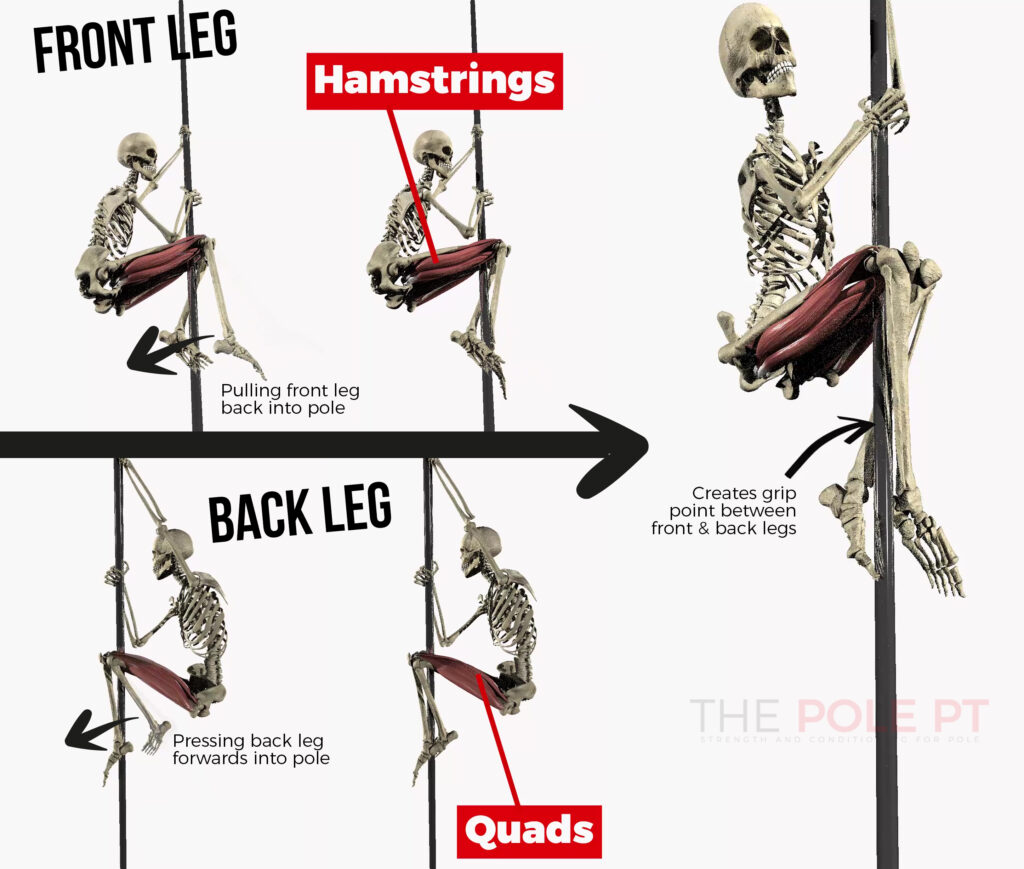
Sandwiching the pole like this (between our front and back legs and between our thighs) helps us create friction around the pole, so we’ve got a nice solid base from which to generate force.
If we try to move without that solid leg grip, our feet can start to slide down the pole and/or our knees and hips start to shift forwards as we try to lift, which can make our climb less efficient and more challenging.
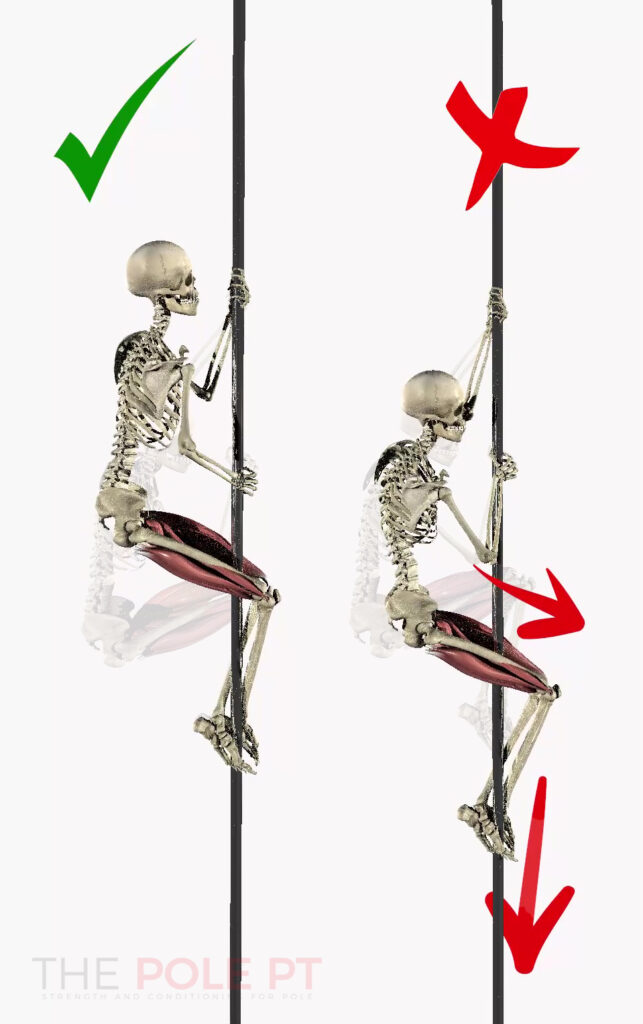
But if we can maintain that strong grip with our legs, we can then use the stability of the pole to put those squatting muscles to good use!
Just like when we squat, our quads work to straighten our legs, and our glute max and hamstrings extend our hips – BAM! We can lift our hips up, reset our position and go again!
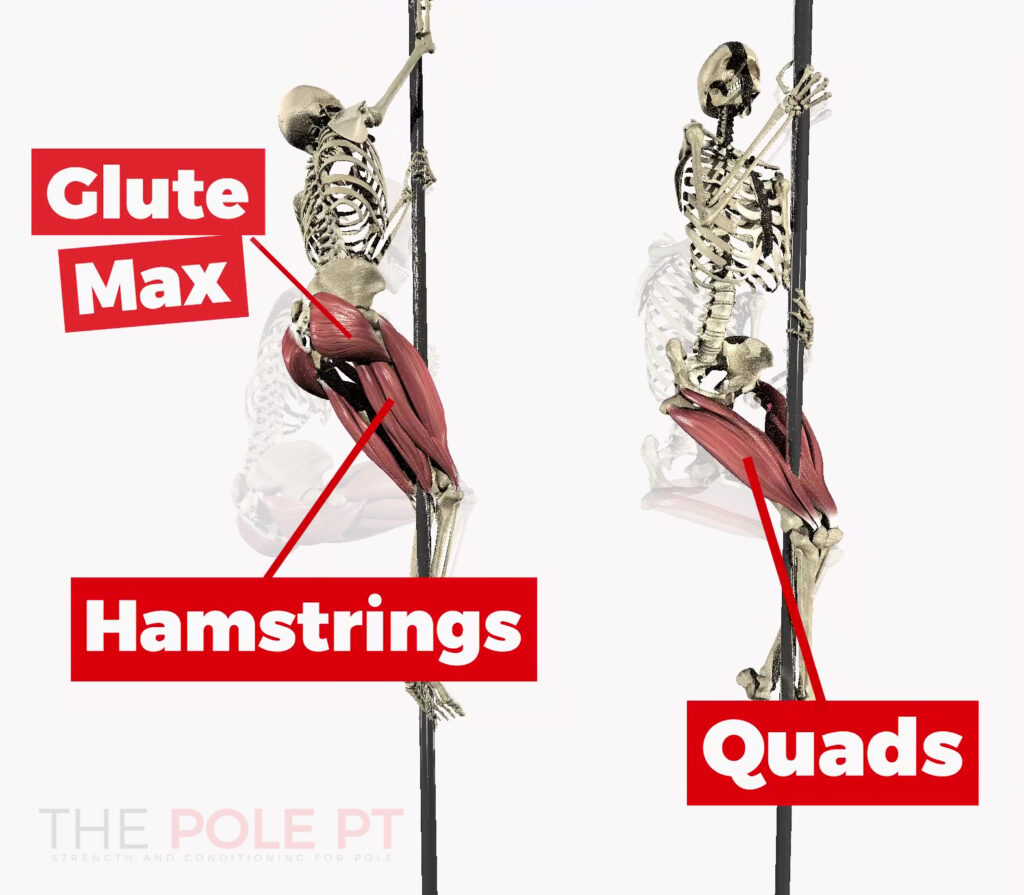
Nerd alert! With the legs adducted towards our midline and our hammies and quads working to sandwich the pole between our lower legs, there will no doubt be some differences in which muscles (within the main muscle groups) are working most, when compared to our usual ground-dwelling squat. For instance, the hip adduction may mean that the vastus medialis (the quadriceps muscle closest to our midline) is activated a little more in the pole climb compared to a regular squat1.
Also, it’s likely that we don’t use the front and back legs evenly when we climb. I’d wager that the back leg is doing most of the heavy lifting, but using that front leg and the hip adduction to create additional friction around the pole means we don’t need to rely soley on that back leg push into the pole.
Of course, our upper body is working too, but if we can use the muscles of our lower body through that squat-like movement pattern, we can better distribute the load of the climb, reducing the amount of effort needed from our upper body.
I know, right! I told you it was magic!
Leg day for pole dancers – let’s go!
I’ve picked 4 lower body exercises for building pole climb strength.
You can use ‘off the pole’ exercises like this, alongside your ‘on the pole’ training, to give your skill-specific strength a ‘leg-up’ (yeah, I love a pun)! Add these to your leg day programming and get ready for your strongest pole climbs yet!
Bonus! I’ve included some rep and set suggestions along with a leg day ‘takeaway’ at the end so you’ve got a super-speedy climb-specific lower body workout you can do today!
Pole climb Exercise #1 Goblet Squat
Given how we use the squat movement pattern in the climb, it’d be rude not to include a good old fashioned squat, wouldn’t it?
I’m demo-ing the Goblet squat here – my favourite! New to squats? You can start with a bodyweight or banded version and add weight gradually. Already squatting for dayz? You can try progressing to a barbell squat to increase the load.
Pole climb Exercise #2: Adductor Lifts
Your average gym-based lower body workout tends to neglect training hip adduction directly, but strong adductors (inner thigh muscles) are key for climbing the pole (not to mention pole sits, laybacks… and basically any move where we have the pole between our legs), so you betcha my leg day workout for pole dancers features some adductor work!
I LOVE this hip adductor exercise as it combines isometric work (holding the engagement on the top leg) with concentric leg lifts on the bottom leg. Simple but sooooo powerful!
Pole climb Exercise #3: Resisted leg extension
This exercise really isolates the quad muscles (the ones that are particularly important for pressing that back leg into the pole when we climb).
I’m demo-ing a resistance band version here, but if you have a leg extension machine at the gym, have at it!
Pole climb Exercise #4: Hamstring Curl
Our hamstrings play a couple of important roles in our pole climb. We use them (along with our glutes) to lift our hips up out of the bottom of our pole climb position, but we also use them to keep the bottom of our front leg in contact with the pole (so we can squeeze the pole between our front and back legs). Hamstrings are also a commonly injured area for pole dancers, so hamstring-focused exercises like this are a common feature in my exercise programming for pole dancers.
The hamstring curl using the stability ball is challenging! I love that it adds some additional core and hip stabilisation work, but if you can’t do this one yet with good form, switch to a resistance band hamstring curl which really isolates the hamstrings and takes out the glute and core stabilization demands of the stability ball curl.
You can find some other hamstring training tips in my post: Hello Hamstrings!
Super-speedy climb-specific lower body workout!
If you’re not sure how to incorporate these exercises into a workout, here’s my suggestion…
WARM UP: Spend 5-8 minutes warming up! Include some general movement that feels good, focusing on the lower body (I love these over and unders, for example) and some bodyweight variations of the movement patterns you’ll be doing in your supersets (e.g. bodyweight squats, glute bridges).
SUPERSETS:
*A superset basically just means doing each exercise in the set back-to-back, without resting in between! Buuuut: make sure you add rest if you need it to keep good form!*
Superset 1
Goblet Squat (10 reps) / Adductor Lift (12 reps each side)
x 3 sets
Superset 2:
Leg Extension (10 reps each side) / Hamstring Curl (8 reps)
x 3 sets
COOL DOWN: After your supersets, spend 5 minutes or so cooling down and stretching the muscles you’ve worked. I’d recommend including a glute stretch, hamstring stretch, quad stretch and adductor stretch for 20 second holds!
That workout should only take around 20 mins! Boom! Short but mighty!
Finally
I hope this little ‘leg day’ workout gives you a big chunk of the puzzle that is often missed when building strength for the pole climb, but remember: our legs aren’t the only things working in our climb!
We use our upper body, hip flexors and core, too! If you want to cover all aspects of climbing strength, I’d recommend throwing in some vertical pulling work, some lateral spinal flexion and flexion/extension core stabilization work alongside your skill training to complete the whole picture!*
*Want some help with that? You can learn how to programme your training for pole with my book Strength and Conditioning for Pole! It gives you a full framework to plan your training, following the logic/magic of sports science!
PS. My full anatomy breakdown of the forearm climb movement is dropping sooooon! Stay tuned if you’re hungry for more nerdy details! 🙂
1 Hyong IH. Effects of squats accompanied by hip joint adduction on the selective activity of the vastus medialis oblique. J Phys Ther Sci. 2015 Jun;27(6):1979-81. doi: 10.1589/jpts.27.1979. Epub 2015 Jun 30. PMID: 26180362; PMCID: PMC4500025.


